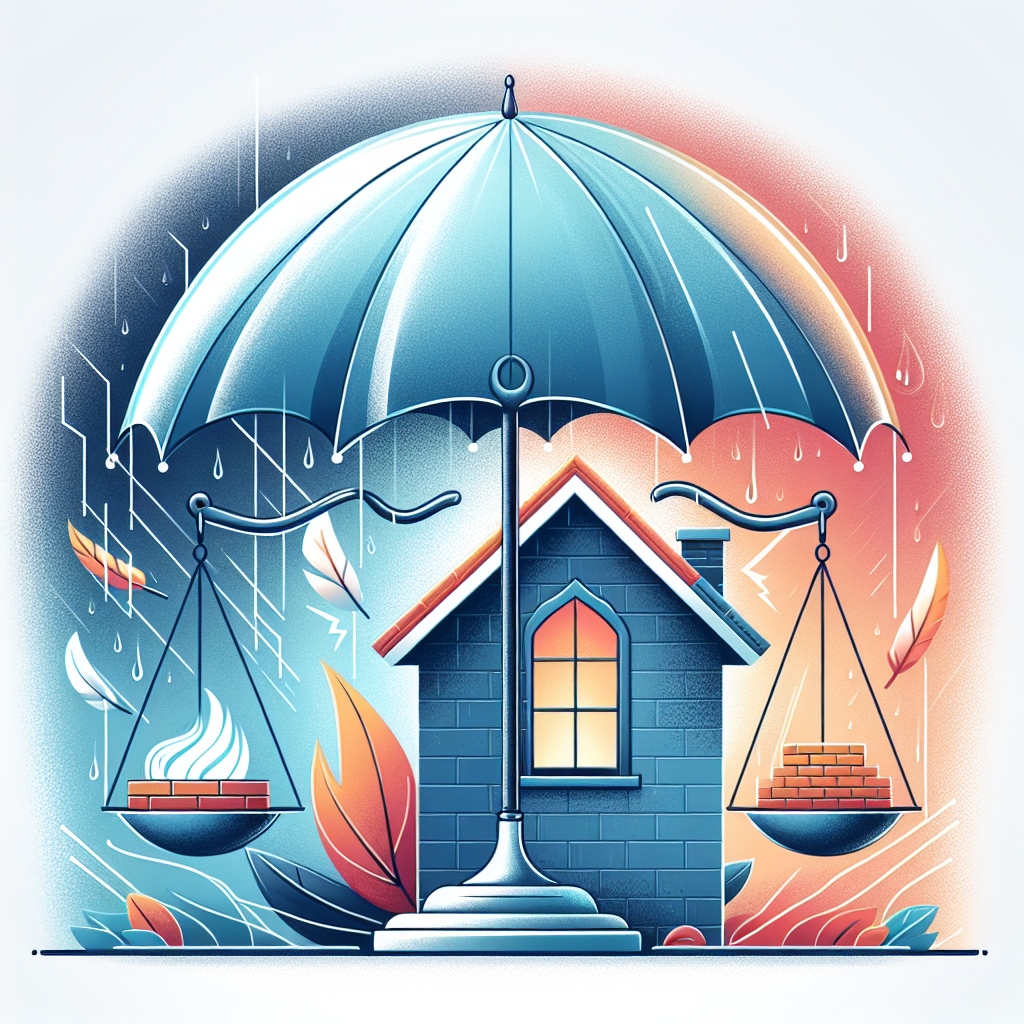Filed under Home Insurance on
How to Understand Home Insurance Coverage: A Simple Guide

If you own a home, you probably bought a policy, tucked the paperwork in a drawer, and hoped never to use it. Yet the fastest way to protect your budget—and sleep better—is to actually understand what your policy covers, what it doesn’t, and how to tailor it to your risks. This simple, practical guide breaks down the essentials so you can make smart decisions about limits, deductibles, endorsements, and claims. Along the way, you’ll learn how to translate industry jargon, avoid common pitfalls, and keep pace with the trends reshaping the market.
What a Homeowners Policy Really Covers
Most homeowners policies follow a familiar structure. You’ll see these core parts on your declarations page:
- Dwelling (Coverage A): Pays to repair or rebuild the home itself—walls, roof, built-ins.
- Other Structures (Coverage B): Covers things like detached garages, sheds, and fences.
- Personal Property (Coverage C): Covers your belongings—furniture, electronics, clothes.
- Loss of Use/Additional Living Expense (Coverage D): Pays for temporary housing and extra costs if you can’t live at home due to a covered loss.
- Personal Liability (Coverage E): Protects you if you’re legally responsible for injury or property damage to others.
- Medical Payments to Others (Coverage F): Helps with small medical bills if a guest is injured on your property, regardless of fault.
Policy types matter, too. HO-3 is the most common for single-family homes and typically offers “open-peril” coverage on the dwelling and “named-peril” coverage on belongings. HO-5 is broader and often offers open-peril protection for both structure and contents. Condo owners generally have HO-6, renters have HO-4, and older or special-case homes may use HO-1 or HO-2, which are more limited.
Perils, Exclusions, and the Fine Print
Insurance isn’t a maintenance plan. It is designed for sudden, accidental losses—not wear and tear. Most policies cover fire, wind, hail, theft, vandalism, and certain types of water damage (like burst pipes). Key exclusions commonly include:
- Flood from rising water or storm surge (handled by separate flood insurance).
- Earthquake and earth movement (usually a separate policy or endorsement).
- Neglect, deterioration, rust, rot, and mold (limited coverage may be available).
- Sewer and drain backups (typically optional coverage).
- Power failure off premises and certain types of collapse or settling.
Policies also attach special deductibles for specific risks in many coastal and hail-prone regions. You may see percentage-based hurricane, named-storm, or wind/hail deductibles calculated on the dwelling limit (for example, 2% of Coverage A).
How Coverage Works in Real Life
It’s easier to understand home insurance coverage when you map it to real events:
- Kitchen fire: Dwelling coverage repairs the structure; personal property covers damaged appliances and cookware; loss of use pays for a short-term rental if the home is uninhabitable during repairs.
- Burst pipe: Typically covered if sudden and accidental. You’re responsible for keeping heat on and maintaining the home to avoid freezing and neglect exclusions.
- Windstorm damages roof: Dwelling coverage applies, but your roof’s age and material can affect how much you’re paid and which deductible applies.
- Theft: Personal property coverage responds. High-value items might be subject to low sublimits unless they’re specifically scheduled.
- Guest injury on icy steps: Liability coverage can pay legal defense and settlements; medical payments can handle smaller medical bills quickly.
Understanding Limits and Sublimits
Your policy has a top-line limit for each section, plus numerous sublimits for specific items. These smaller limits catch many people off guard after a claim. Common sublimits include:
- Jewelry, watches, and furs (often $1,500–$2,500 total for theft losses).
- Firearms, silverware, and cash (modest amounts unless scheduled).
- Business property at home (usually very limited without an endorsement).
- Trailers, boats, and certain collectibles (coverage typically limited or excluded).
Scheduling valuable items (adding a “floater”) can provide higher limits, broader protection, and sometimes no deductible. If a few items—like an engagement ring or rare art—would be painful to replace out of pocket, scheduling is the straightforward solution.
Replacement Cost vs. Actual Cash Value
Two valuation methods can dramatically change claim outcomes:
- Replacement Cost Value (RCV): Pays the cost to replace with new materials of like kind and quality, without depreciation.
- Actual Cash Value (ACV): Pays the depreciated value (what the item is worth today), which can be far lower than the replacement cost.
Most modern policies provide replacement cost for the structure, but policies vary for personal property. If your contents are at ACV, upgrading to replacement cost is often worth it. Be aware of roof endorsements that shift older roofs to ACV—even if your dwelling is otherwise RCV. Read that section closely; a large depreciation hit on a roof claim can be painful.
Consider “extended” or “guaranteed” replacement cost on the dwelling. With construction inflation still elevated in many areas, an extra 20–50% buffer above your base dwelling limit helps absorb cost spikes after catastrophes. Also look for ordinance or law coverage, which pays for code upgrades required during repair—crucial for older homes.
Additional Coverages Worth Considering
Depending on your home, location, and risk tolerance, these options can add meaningful protection:
- Water backup of sewers and drains: Covers damage from backups and sump overflow; a common, messy, and expensive loss.
- Service line coverage: Pays to repair underground utility lines from the house to the street (water, sewer, electric, gas).
- Equipment breakdown: Covers home systems like HVAC, appliances, and electrical panels from sudden mechanical breakdown.
- Flood insurance: Standard policies exclude flood. Separate coverage is available through the National Flood Insurance Program and private insurers.
- Earthquake insurance: Essential in quake-prone states, usually with a higher deductible.
- Umbrella liability: An extra $1–$5 million of protection above home and auto liability for serious injury lawsuits or large judgments.
- Identity theft and cyber: Can help with remediation costs if your identity is compromised or you face cyber extortion or fraud.
- Condo loss assessment (HO-6): Protects you if the association assesses unit owners for a covered loss to shared property.
Liability: Your Most Undervalued Coverage
Property coverage fixes your house. Liability coverage protects your future earnings, savings, investments, and even your home equity. Consider:
- Dog bites and animal liability: Some breeds are excluded by certain carriers; disclose accurately.
- Pools, trampolines, and “attractive nuisances”: Heightened risk requires safety measures and often higher limits.
- Personal injury endorsement: Extends liability to libel, slander, or false arrest claims—useful in the social media era.
Many homeowners carry only $100,000–$300,000 of liability. Consider raising this to $500,000 or $1 million, and add an umbrella for more. Premium increases are typically modest compared with the protection gained.
Deductibles and What They Mean for You
Your deductible is the portion you pay before insurance responds. Higher deductibles reduce premiums but shift more risk to you. You may have:
- A standard all-perils deductible (for example, $1,000 or $2,500).
- A separate wind/hail or hurricane deductible, often a percentage of your dwelling limit.
Think in totals, not just percentages. A 2% hurricane deductible on a $500,000 home equals $10,000 out of pocket. Set deductibles you can comfortably handle without derailing your finances, and maintain an emergency fund to match.
How Insurers Price Policies
Carriers price risk using location, construction, and personal factors. While specifics vary by state and company, common rating elements include:
- Address-based risks: Wildfire, flood, hail, tornado, and hurricane exposure; distance to fire station and hydrant.
- Home characteristics: Roof age/material, updates to plumbing and electrical, square footage, and building quality.
- Claims and credit-based insurance score (where allowed): Prior losses and credit behavior correlate with future claims frequency.
- Security and mitigation: Monitored alarms, water-leak sensors, automatic shutoff valves, and fortified roofs can reduce rates.
- Policy structure: Deductibles, endorsements, and the replacement cost vs. ACV choice.
Bundling home and auto, staying claim-free, and installing risk-mitigation tech often earn meaningful discounts. Independent agents can shop multiple insurers to find the best mix of price, stability, and coverage.
The Claims Process, Step by Step
- Protect people first. Then prevent further damage: shut off water, board up windows, or tarp a roof as needed.
- Document everything: Take photos and videos before cleanup. Save receipts for temporary repairs and additional living expenses.
- Notify your insurer or agent promptly: Many policies have timelines for reporting a claim.
- Meet the adjuster: Walk through damage, share your inventory and receipts, and discuss repair options.
- Understand payments: Some claims pay ACV first, then release “recoverable depreciation” after you complete repairs.
- Choose contractors wisely: Verify licenses and insurance, get multiple estimates, and watch for post-catastrophe scams.
- Know your dispute options: Appraisal, mediation, or hiring a public adjuster or attorney can help if you reach an impasse.
Keep copies of all communications and confirm agreements in writing. If you feel rushed, remember: it’s okay to ask for clarification or time to review documents.
Market Trends You Should Know
The home insurance market is changing rapidly, and understanding these shifts helps you make proactive choices:
- Severe weather volatility: Industry analyses show severe convective storms—hail, straight-line winds, and tornadoes—have produced record insured losses in recent years. That volatility can mean higher premiums and tighter underwriting in affected states.
- Rebuild cost inflation: Labor shortages, materials price swings, and supply chain pressures have pushed reconstruction costs up. This is a strong argument for extended replacement cost and inflation guard endorsements.
- Insurer capacity and underwriting: In wildfire- and hurricane-prone regions, some carriers have paused new business, raised deductibles, or adjusted roof coverage terms. Expect more scrutiny on roof age, dogs, and liability exposures like pools.
- Mitigation matters: Programs like IBHS FORTIFIED roofing standards have shown loss reductions in wind events. Many insurers reward fortified or impact-resistant roofs and leak-detection technology with discounts.
- Data-driven pricing: More granular property data (roof imagery, wildfire risk scores, water damage sensors) increasingly shapes premiums and eligibility.
Bottom line: Periodically recalibrate your home insurance coverage—especially after renovations, local code changes, or major weather events.
Common Myths, Clear Answers
- “Market value equals my insurance limit.” False. Insure to rebuild cost, not what your home would sell for. Land value doesn’t need insurance; construction costs do.
- “Flood damage is covered.” Not by standard policies. You need separate flood insurance, even outside high-risk zones.
- “If my neighbor’s tree damages my home, they pay.” Your own policy usually pays, unless you can prove negligence (e.g., the neighbor ignored a known hazard).
- “Home-based business gear is fully covered.” Often not. Business property has low sublimits at home and even lower off premises. Consider a separate business policy or endorsements.
- “Vacant means the same as unoccupied.” No. Vacant homes may have reduced or excluded coverage after a set period. Tell your insurer if the home will be empty for an extended time.
How to Right-Size Your Coverage
Use this checklist to align your policy with your risks and budget:
- Calculate rebuild cost: Ask your agent for a replacement cost estimate that reflects today’s materials and labor.
- Add a cushion: Consider extended or guaranteed replacement cost and ordinance or law coverage.
- Upgrade contents valuation: Switch to replacement cost if your policy uses ACV for personal property.
- Schedule valuables: Appraise and list high-value items to avoid sublimit surprises.
- Boost liability: Raise limits to at least $500,000 and add an umbrella if you have assets to protect.
- Tailor endorsements: Water backup, service line, equipment breakdown, and personal injury can fill common gaps.
- Set deductibles strategically: Balance premium savings with an emergency fund you can actually use.
- Shop smart: Compare at least three quotes, focusing on endorsements, limits, and claims service—not just price.
Annual Coverage Tune-Up
Once a year, do a quick review. Life changes fast—and so do risks.
- Major updates: New roof, finished basement, or kitchen remodel? Tell your agent so limits reflect the added value.
- Inventory refresh: Keep a digital home inventory with photos, serial numbers, and receipts. Back it up to the cloud.
- Mitigation audit: Install smart leak detectors, maintain gutters and roofs, trim trees, and confirm smoke/CO alarms are working.
- Lifestyle check: New dog, trampoline, or home-based business? You may need endorsements or higher liability limits.
- Shop when needed: If premiums jump or coverage changes, ask your agent to reshop the market.
Special Considerations for Condos and Rentals
Condo owners need to coordinate coverage with the association’s master policy. Understand the “walls-in” responsibility, special assessments, and any gaps for fixtures and improvements. Talk to your agent about loss assessment coverage and betterments and improvements.
Renters should still carry personal property and liability coverage through an HO-4 policy. Landlords insure the building; you insure your belongings and your liability.
Expert Tips to Get More Value
- Pair coverage with risk reduction: Combining a water shutoff valve or leak sensors with water backup coverage offers strong, layered protection.
- Know your roof: Many carriers adjust terms around roof age and material. Impact-resistant shingles can earn discounts and limit hail losses.
- Ask about claim forgiveness: Some insurers offer benefits for long-term customers who remain loss-free.
- Request a “new purchase” or “newly renovated” review: You may qualify for better pricing or need updated limits after improvements.
- Coordinate with estate planning: Liability and umbrella decisions should match your asset picture and future goals.
Quick Glossary
- Declarations (Dec) Page: The summary showing your limits, deductibles, endorsements, and premium.
- Endorsement/Rider: An add-on that changes coverage—expands, limits, or clarifies terms.
- Sublimit: A smaller cap within a coverage category for specific items, like jewelry or cash.
- Peril: A cause of loss (fire, wind, hail) that a policy may cover or exclude.
- Open-Peril vs. Named-Peril: Open-peril covers all causes except those excluded; named-peril covers only listed causes.
- Ordinance or Law: Pays for code-required upgrades during repairs following a covered loss.
- Recoverable Depreciation: The difference between ACV and RCV you receive after completing repairs.
Putting It All Together
Understanding home insurance coverage isn’t about memorizing every clause—it’s about focusing on the decisions that matter most. Insure to accurate rebuild cost, choose replacement cost for contents, add buffers for inflation and code upgrades, and raise liability limits to match your risk. Then, fill common gaps with targeted endorsements like water backup or service line coverage, and protect your premiums with practical mitigation steps.
Industry groups like the Insurance Information Institute and NAIC emphasize regular policy reviews, accurate replacement cost estimates, and proactive risk management. Claims data bear this out: losses tend to be less severe in homes with modern roofs, updated systems, and water-leak detection. As severe weather and rebuild costs evolve, so should your plan.
Finally, work with a trusted agent who can explain trade-offs clearly and reshop when markets shift. The goal isn’t to buy the cheapest policy; it’s to match your unique risks with strong, flexible protection—so a bad day doesn’t become a financial crisis.
Key Takeaways at a Glance
- Insure to rebuild cost, not market value; consider extended replacement cost and ordinance or law coverage.
- Confirm whether your contents are RCV or ACV; upgrade to replacement cost if needed.
- Raise liability limits and consider an umbrella to protect assets.
- Add targeted endorsements to fill gaps: water backup, service line, equipment breakdown.
- Use mitigation to earn discounts and reduce claims: fortified roofs, leak sensors, alarms.
- Review and update your policy after renovations, major purchases, or lifestyle changes.
FAQ: Quick Answers to Common Questions
How often should I review my policy? Annually, and whenever you renovate, add high-value items, or change occupancy.
Is flood insurance only for coastal homes? No. FEMA data show many flood claims occur outside designated high-risk zones. Consider flood coverage if you’re near rivers, creeks, or heavy rainfall areas.
Can I choose my own contractor after a claim? Typically yes. Insurers may suggest vendors, but you usually have the final say. Verify licenses and check references.
What if I disagree with the adjuster’s estimate? You can request reinspection, provide competing contractor estimates, or invoke appraisal per your policy’s dispute clause.
Will filing a small claim raise my rates? It can. Ask your agent to model the impact before filing small losses—you may be better off paying out of pocket to preserve claim-free discounts.
The Bottom Line
When you demystify home insurance coverage, you gain control: you can set the right limits, plug the right gaps, and know exactly what to do on your worst day. Treat your policy like a living plan—update it as your home and life change, and lean on an experienced agent for context and negotiation. With the right structure in place, you’ll be ready for the unexpected—and confident your home, belongings, and financial future are well protected.
Strategic Use of the Primary Keyword
If you’re researching quotes or comparing policies, search for phrases like “home insurance coverage for older roofs,” “water backup endorsement,” and “extended replacement cost for home insurance” so you can surface options tailored to your situation. By aligning your upgrades and mitigation steps with your policy’s terms, you’ll squeeze more value from your home insurance coverage and avoid unpleasant surprises later. Remember: home insurance coverage isn’t one-size-fits-all; it’s a custom-fit safety net that should evolve with your home and your life.





